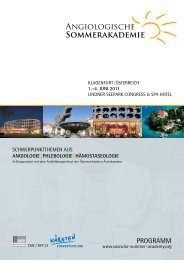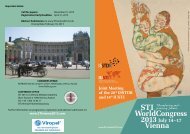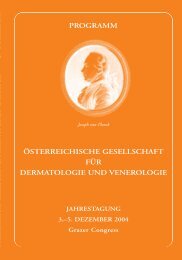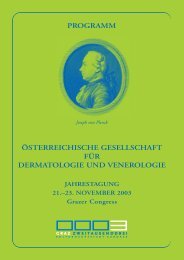PROGRAMM JAHRESTAGUNG 2012 30. Nov. – 2. Dez ... - ÖGDV
PROGRAMM JAHRESTAGUNG 2012 30. Nov. – 2. Dez ... - ÖGDV
PROGRAMM JAHRESTAGUNG 2012 30. Nov. – 2. Dez ... - ÖGDV
Erfolgreiche ePaper selbst erstellen
Machen Sie aus Ihren PDF Publikationen ein blätterbares Flipbook mit unserer einzigartigen Google optimierten e-Paper Software.
Poster Allergologie und Immunologie<br />
P 6<br />
IL-22 and Th2 cytokines predominate in acute cutaneous graft-versus-host<br />
disease.<br />
Marie-Charlotte Brueggen 1<br />
Irene Klein 1<br />
Hildegard Greinix 2<br />
Wolfgang Bauer 1<br />
Zoya Kuzmina 2<br />
Werner Rabitsch 2<br />
Robert Knobler 3<br />
Georg Stingl 1<br />
Georg Stary 1<br />
1 Department of Dermatology, DIAID, Medical University of Vienna<br />
2 Department of Internal Medicine I, Bone Marrow Transplantation, Medical University<br />
of Vienna<br />
3 Department of Dermatology, Division of General Dermatology, Medical University of<br />
Vienna, Währinger Gürtel 18-20, A-1090 Vienna<br />
Introduction: Graft-versus-host disease (GvHD) is the major clinical complication of<br />
allogeneic hematopoietic stem cell transplantation (HCT) occurring in an acute and<br />
chronic form. We still do not understand the pathomechanisms leading to the distinct<br />
clinical presentations of GvHD.<br />
Methods: To address this issue, we collected lesional skin biopsies of patients suffering<br />
from acute (aGvHD) (n=22) and chronic inflammatory (cGvHD) (n=15) GvHD as well as<br />
serial biopsies of non-lesional skin from HCT recipients at different time points prior<br />
and after HCT (n=14). The cellular infiltrate was analyzed by immunofluorescence<br />
stainings; interleukins and chemokines were assessed by real-time RT-PCR.<br />
Results: While CD4+ and CD8+ T-cells dominated the inflammatory infiltrate in both<br />
acute and chronic GVHD, analysis of the quality of the T cell-mediated immune response<br />
revealed striking differences between the two forms. In aGvHD lesions, there was a<br />
predominance of Th2 cytokines (IL-4, IL-13) and Th2 chemokines (CCL17, CCL22). To our<br />
great surprise, levels of IL-22 but not IL-17 were also highly increased in aGvHD but not<br />
in cGvHD skin lesions, suggesting that IL-22 single-producing are major effector cells<br />
in aGvHD. In accordance with these findings, levels of TSLP, a keratinocyte-derived<br />
cytokine skewing the immune response towards a Th2 direction, were increased at day<br />
20 after HCT in non-lesional skin of patients who would later develop aGvHD. The<br />
immune response occurring in cGvHD skin lesions was characterized by a Th1 pattern,<br />
as evidenced by a relative increase of Th1 chemokines (CCL5, CCR5, CXCL9, CXCL10) as<br />
well as Th1 (IFN-gamma, IL-12/IL-23p40) and Th17 (IL23p19) cytokines. Our findings<br />
shed new light on the pathomechanisms operative in the different manifestations of<br />
cutaneous GvHD and, furthermore, identify molecular signatures to more accurately<br />
predict and verify the occurrence of this disease.<br />
45









